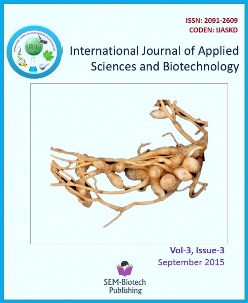Use of Chemical Fungicides for the Management of Rice Blast (Pyricularia Grisea) Disease at Jyotinagar, Chitwan, Nepal
DOI:
https://doi.org/10.3126/ijasbt.v3i3.13287Keywords:
rice blast, Pyricularia grisea, fungicides, severity, incidenceAbstract
Rice blast caused by Pyricularia grisea Sacc. is the important disease of rice and different fungicides against this disease were evaluated in summer 2014 at Karma Research and Development Center, Jyotinagar, Chitwan, Nepal. A susceptible rice cultivar ‘Mansuli’ was planted in randomized complete block design and fungicides viz. Tricyclazole 22% + Hexaconazole 3% SC (0.2%), Streptomycin 5% + Thiophanate Methyl 50% WP (0.15%), Prochloraz 25% EC (0.3%), Kasugamycin 2% WP (0.2%), Hexaconazole 4% + Zineb 68 % WP (0.2%) and Udaan (Hexaconazole 3% SC) (0.2%) were sprayed thrice at weekly interval starting from the booting stage. All these fungicides were found to be effective in controlling leaf and neck blast disease as compare to control one. Among them, Tricyclazole 22% + Hexaconazole 3% SC was found to be the most effective with least leaf blast severity (6.23%), neck blast incidence (8.97%), and highest percentage disease control (87.08% and 79.62% in leaf blast and neck blast respectively) and grain yield (4.23 t/ha) followed by Prochloraz 25% EC (0.3%) and Udaan (Hexaconazole 3% SC) (0.2%). It is therefore concluded that Tricyclazole 22% + Hexaconazole 3% SC fungicide could be used to control rice blast at weekly interval starting from the booting stage for three times.
Int J Appl Sci Biotechnol, Vol 3(3): 474-478




